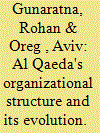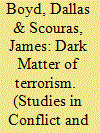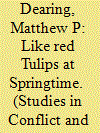| Srl | Item |
| 1 |
ID:
099786


|
|
|
|
|
| Publication |
2010.
|
| Summary/Abstract |
The inner organizational structure of Al Qaeda within the expanded framework of the "Global Jihad movement" has been a subject of much debate between scholars. As will be elaborated later, the "Global Jihad movement" is composed of several elements that possess radical Islamic ideology and conduct operational activity in different regions in the world under the banner of Jihad. The dominant factor within the "Global Jihad movement" is by no doubt Al Qaeda. The purpose of this article is to focus solely on Al Qaeda and present the formal internal structure of the organization. The article argues that Al Qaeda is first and foremost, an infrastructural organization with a formal echelon, hierarchy, sub-departmental division, and duties distribution reflecting characteristics of a guerilla and terrorist organization. The article portrays the formal layout of Al Qaeda, composed of the main command apparatus, and names the different personalities who fill the more important positions within Al Qaeda's hierarchy from its days of inception until today.
|
|
|
|
|
|
|
|
|
|
|
|
|
|
|
|
| 2 |
ID:
099789


|
|
|
|
|
| Publication |
2010.
|
| Summary/Abstract |
The consequences of states' reactions to terrorist attacks can far outweigh the effects of the attacks themselves. Yet risk analysis, widely accepted as the proper analytical basis for assessing terrorist threats, largely ignores the consequences from potential reactions to attacks. It also generally fails to consider how the anticipation of these reactions may influence terrorists' attack preferences. Policymakers should therefore be wary of the limitations of risk analysis as currently practiced. Further, states should strive to avoid reactions to attacks that unwittingly further their adversaries' agendas, a goal that may be aided by strengthening public resilience to terrorism.
|
|
|
|
|
|
|
|
|
|
|
|
|
|
|
|
| 3 |
ID:
099787


|
|
|
|
|
| Publication |
2010.
|
| Summary/Abstract |
In an era where female suicide terrorism is on the rise in conflict regions such as the Middle East, the North Caucasus, and South Asia, why has Afghanistan been largely immune to this trend? Why do some violent groups use female suicide terrorism and others avoid it? This is a critical question for policy makers and analysts attempting to understand a dangerous terrorist phenomenon and how it may evolve in Afghanistan. During the anti-Soviet jihad, narratives were woven of men and women marching through the mountains of Nuristan to "offer their blood for the Islamic revolution like red tulips at springtime." But today, women are wholly absent from the Taliban and their jihad in Afghanistan. This article analyzes, in particular, the absence of women in Taliban martyrdom operations. There are three primary findings from this study that explain the low propensity for female suicide bombers in Afghanistan. First, a permissive social and geographic environment in Afghanistan gives insurgents freedom of mobility and a resistance capacity characterized by a reduced necessity for female suicide bombers; second, the capacity of a fiercely conservative culture restricts female participation in both Afghan society and within insurgent organizations; and third, the pronounced absence of a female culture of martyrdom limits women from participation in insurgent actions and narratives.
|
|
|
|
|
|
|
|
|
|
|
|
|
|
|
|
| 4 |
ID:
099788


|
|
|
|
|
| Publication |
2010.
|
| Summary/Abstract |
This article examines the discursive strategies employed by violent extremists to build a persuasive collective youth identity, drawing from strategic communication, social movement, and membership categorization theories to analyze youth references from texts disseminated by Al Qaeda from 1996-2009. "Youth" is constructed via (a) ascriptions of allegiance to a common belief system whereby militant actions are directed toward establishing a new sociopolitical order, (b) descriptions of pious youth as "true believers" apart from "apostate" state regimes, and (c) references to hagiographies of extremist martyrs that serve as moral exemplars. This article concludes with research directions to facilitate counternarrative interventions.
|
|
|
|
|
|
|
|
|
|
|
|
|
|
|
|